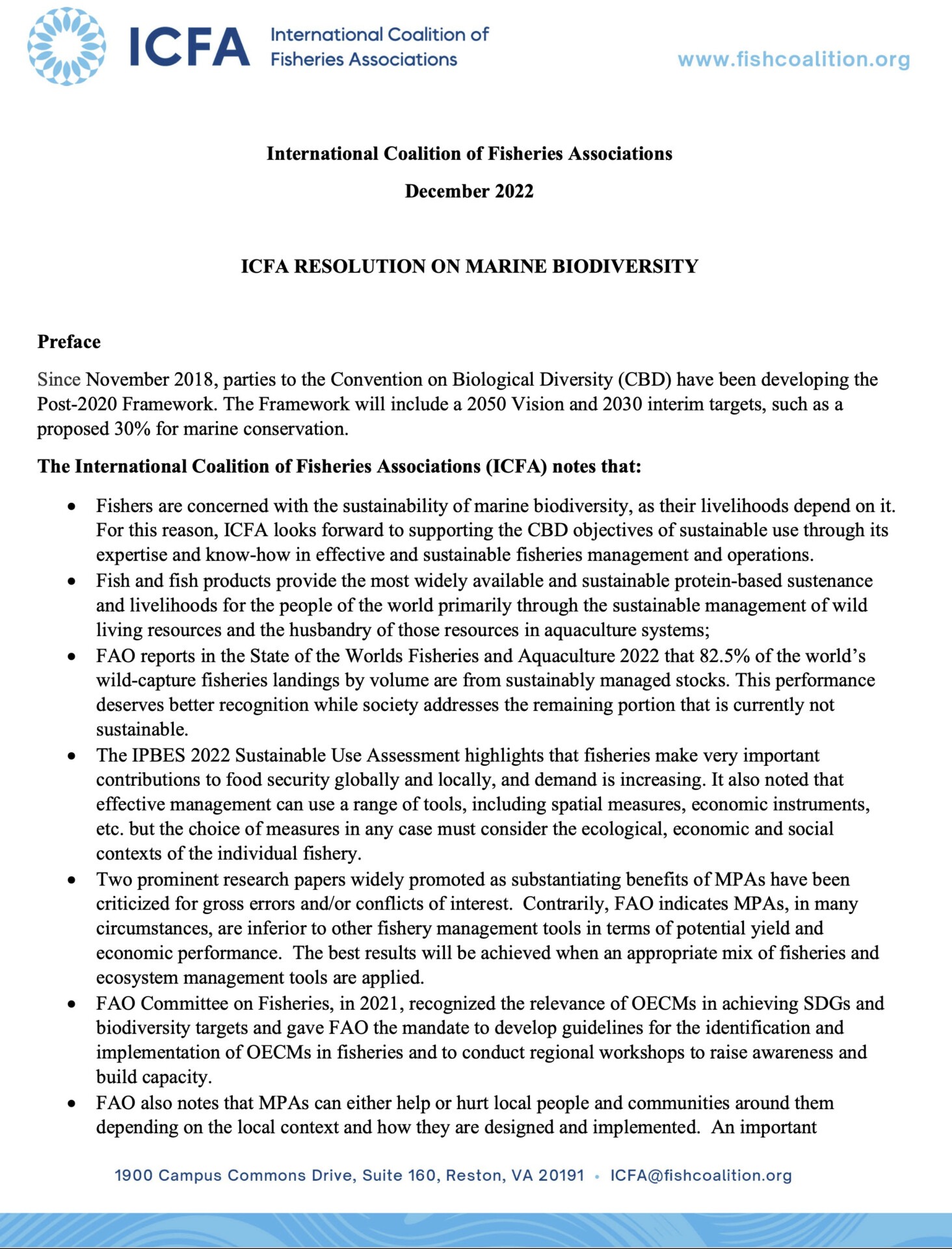ICFA calls for science-based fishing industry planning and management mechanisms for the marine environment are regional scale, multiple-use and consistent with the principles of sustainable development.
Recognition of effective fisheries management as the strongest tool to simultaneously protect ocean health while also fostering human development.
ICFA RESOLUTION ON MARINE BIODIVERSITY
Preface
Since November 2018, parties to the Convention on Biological Diversity (CBD) have been developing the Post-2020 Framework. The Framework will include a 2050 Vision and 2030 interim targets, such as a proposed 30% for marine conservation.
The International Coalition of Fisheries Associations (ICFA) notes that:
- Fishers are concerned with the sustainability of marine biodiversity, as their livelihoods depend on it. For this reason, ICFA looks forward to supporting the CBD objectives of sustainable use through its expertise and know-how in effective and sustainable fisheries management and operations.
- Fish and fish products provide the most widely available and sustainable protein-based sustenance and livelihoods for the people of the world primarily through the sustainable management of wild living resources and the husbandry of those resources in aquaculture systems;
- FAO reports in the State of the Worlds Fisheries and Aquaculture 2022 that 82.5% of the world’s wild-capture fisheries landings by volume are from sustainably managed stocks. This performance deserves better recognition while society addresses the remaining portion that is currently not sustainable.
- The IPBES 2022 Sustainable Use Assessment highlights that fisheries make very important contributions to food security globally and locally, and demand is increasing. It also noted that effective management can use a range of tools, including spatial measures, economic instruments, etc. but the choice of measures in any case must consider the ecological, economic and social contexts of the individual fishery.
- Two prominent research papers widely promoted as substantiating benefits of MPAs have been criticized for gross errors and/or conflicts of interest. Contrarily, FAO indicates MPAs, in many circumstances, are inferior to other fishery management tools in terms of potential yield and economic performance. The best results will be achieved when an appropriate mix of fisheries and ecosystem management tools are applied.
- FAO Committee on Fisheries, in 2021, recognized the relevance of OECMs in achieving SDGs and biodiversity targets and gave FAO the mandate to develop guidelines for the identification and implementation of OECMs in fisheries and to conduct regional workshops to raise awareness and build capacity.
- FAO also notes that MPAs can either help or hurt local people and communities around them depending on the local context and how they are designed and implemented. An important distributional issue with MPAs is that the benefits tend to be diffuse while costs are concentrated. “Failure to take the social and economic context into account in the design and implementation of an MPA can seriously reduce levels of support and compliance with the regulations, and therefore the effectiveness of the MPA.” (FAO, http://www.fao.org/fishery/topic/16201/en, Accessed 7 September 2022)
- Marine Protected Areas (MPAs) and particularly highly protected areas (IUCN Categories 1 and 2) which amongst other things prohibit commercial fishing, are increasingly being promoted internationally by government agencies and NGOs. Some jurisdictions have adopted MPA standards which automatically prohibit certain economic activities without recognizing a direct threat to the protection attribute from such activities.
- The High-Level Panel for a Sustainable Ocean Economy concluded increasing the fraction of ocean-based food in the global diet, and reducing the share of animal-based foods, would contribute significantly to climate change mitigation.
Therefore, ICFA calls for —
- Promotion of sustainable, resilient and low-carbon sources of food from the oceans.
- Recognition of effective fisheries management as the strongest tool to simultaneously protect ocean health while also fostering human development.
- Fishing industry planning and management mechanisms for the marine environment are regional scale, multiple-use and consistent with the principles of sustainable development.
- Recognition of the role of Other Effective Area-Based Conservation Measures as an effective instrument of cross sectoral collaboration between fisheries and biodiversity conservation.
- The fishing industry and fisheries agencies are fully integrated into the decision-making process regarding identification, assessment, justification, delineation, selection, and implementation of MPAs.
- Mainstreaming fisheries considerations in climate discussions, in order to ensure healthy and sustainable seafood for current and future generations under changing climatic conditions.
- Adoption of indicators that are consistent with already-available information processes on marine and coastal biodiversity.
- Before MPAs are implemented:
- The objectives are clearly and unequivocally defined and justified, case by case, including the timeline of the MPA and a review procedure.
- The economic and social impacts of modifying the fishing industry’s access to fisheries resources are determined and considered.
- Rigorous performance assessment, quality assurance standards, methodology, and criteria are developed, and resources are allocated to conduct these assessments through a transparent process, unbiased, independent and collegiate.
- Decisions to close areas are justified on sound ecological grounds, and not for stock reallocation reasons.
- An MPA must have a review mechanism that has been developed and decided upon. The review should consider climate impacts and allow revisions including elimination of the MPA.
